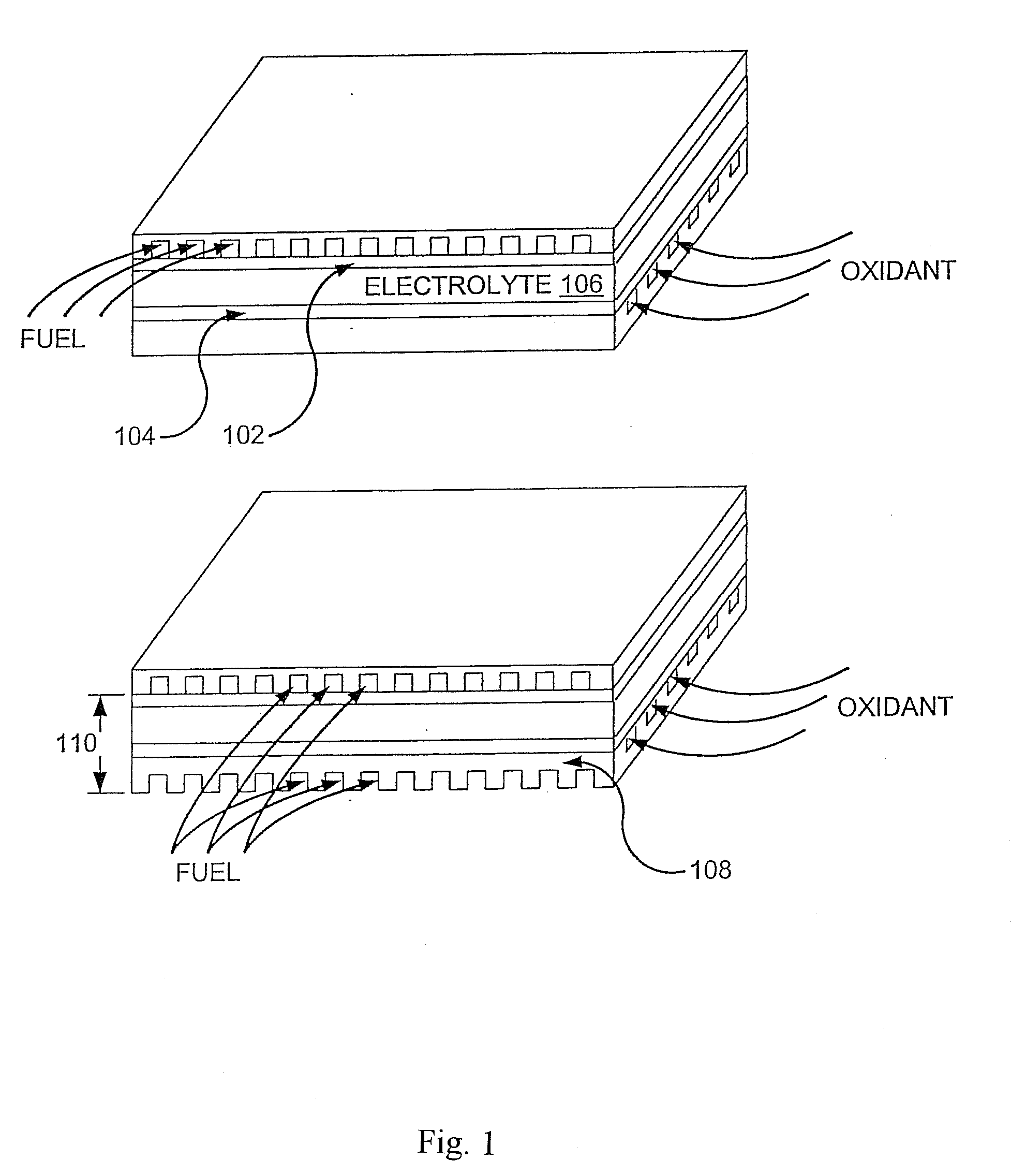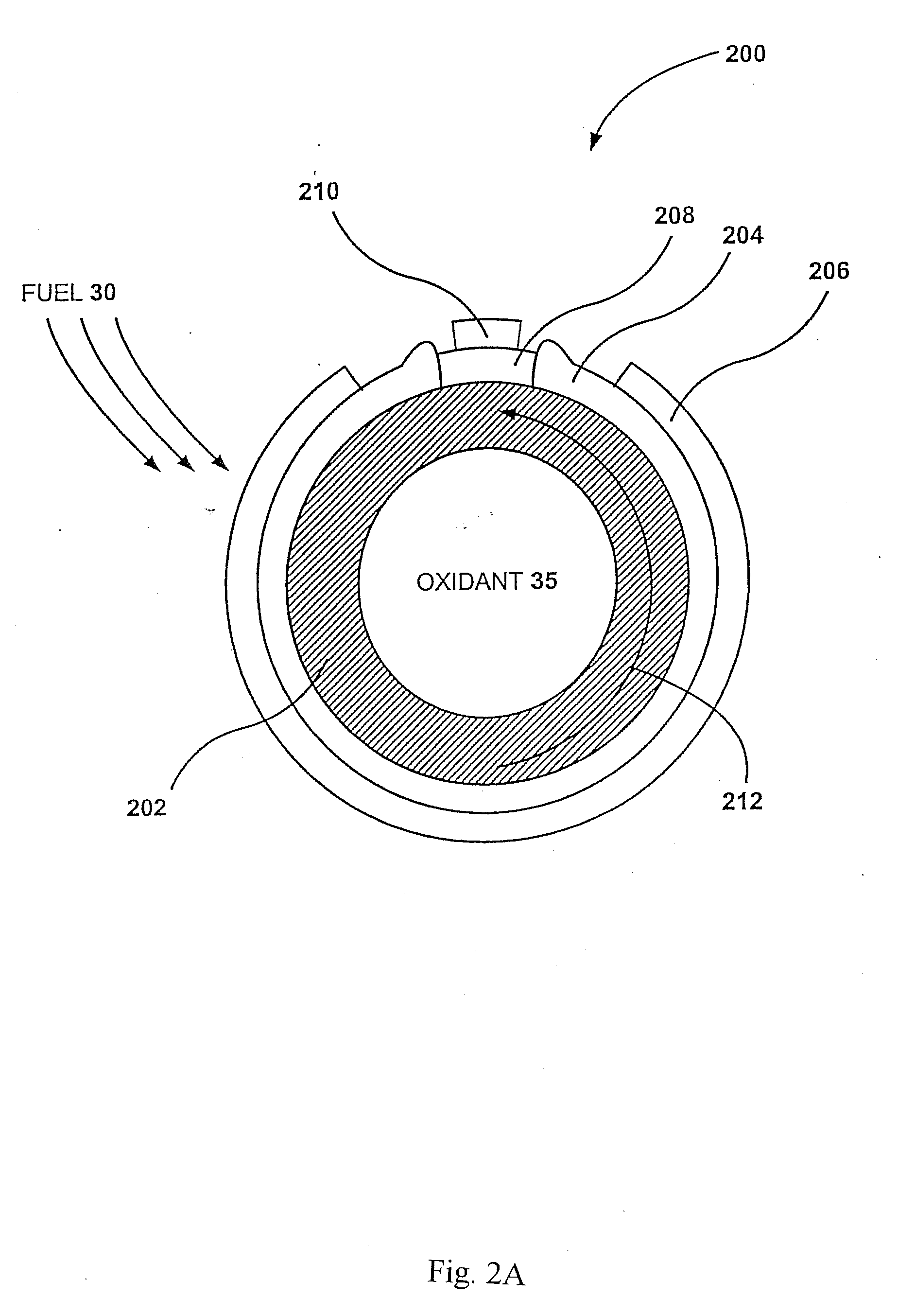Structures for dense, crack free thin films
a thin film, crack-free technology, applied in the field of solid-state electrochemical devices, can solve the problems of inherently high electrical resistance, difficult to maintain, and high cost of ceramic materials used in conventional solid-state electrochemical device implementations, and achieve high electronic conductivity, reduce resistive losses in the device, and high strength
Inactive Publication Date: 2007-06-14
RGT UNIV OF CALIFORNIA
View PDF69 Cites 48 Cited by
- Summary
- Abstract
- Description
- Claims
- Application Information
AI Technical Summary
Benefits of technology
This approach enables the production of solid-state electrochemical devices with enhanced mechanical strength, reduced material costs, and improved performance characteristics, enabling operation at lower temperatures with increased reliability and efficiency.
Problems solved by technology
The ceramic materials used in conventional solid-state electrochemical device implementations can be expensive to manufacture, difficult to maintain (due to their brittleness) and have inherently high electrical resistance.
The ionic resistance may be reduced by operating the devices at high temperatures, typically in excess of 900° C. However, such high temperature operation has significant drawbacks with regard to the device maintenance and the materials available for incorporation into a device, particularly in the oxidizing environment of an oxygen electrode, for example.
Resistive loss attributable to these interconnects can also be significant.
However, these Ni-YSZ supported thin-film structures are mechanically weak, and will deteriorate if exposed to air on SOFC cool-down due to the oxidation of Ni to NiO in oxidizing environments.
Also, nickel is a relatively expensive material, and to use a thick Ni-YSZ substrate as a mechanical support in a solid-state electrochemical device will impose large cost penalties.
However, tubular designs provide less power density than planar designs due to their inherently relatively long current path that results in substantial resistive power loss.
Planar designs are theoretically more efficient than tubular designs, but are generally recognized as having significant safety and reliability issues due to the complexity of sealing and manifolding a planar stack.
Thus, solid state electrochemical devices incorporating current implementations of these cell designs are expensive to manufacture and may suffer from safety, reliability, and / or efficiency drawbacks.
High surface area counter electrodes were fabricated by applying a high surface area powder to a fired bilayer and firing the counter electrode at a temperature sufficient for bonding, but not high enough for significant densification of the electrode.
By firing each electrode separately, uniform neck size could be difficult to achieve in each electrode / electrolyte interface, and subsequently device performance could suffer.
Also, dual firing exposes one electrode to two sintering processes, and the attendant disadvantages therein.
Methods involving sol-gel technology can produce dense, uniform films, but there is a thickness limitation and these are a generally unsuitable for porous substrates.
These thin films suffer from cracking problems during drying or sintering when thicknesses beyond 1 μm are attempted.
This problem is exacerbated when the films are dpeosited on porous substrates, see Kueper et al.
However, the drawback to this technology is the cost of the process.
In the prior art techniques, the importance of the starting green density was not realized, and the effect that the initial compaction would have on the final resultant density.
However, an electrochemical device wherein a porous ceramic layer is deposited on a substrate, compacted prior to firing to high density, and wherein the substrate does not shrink during firing of the ceramic thin film is not known in the art.
The prior art has attempted to solve the aforemetioned problems, but with limited success.
Method used
the structure of the environmentally friendly knitted fabric provided by the present invention; figure 2 Flow chart of the yarn wrapping machine for environmentally friendly knitted fabrics and storage devices; image 3 Is the parameter map of the yarn covering machine
View moreImage
Smart Image Click on the blue labels to locate them in the text.
Smart ImageViewing Examples
Examples
Experimental program
Comparison scheme
Effect test
example 1
[0085] A layer of yttria stabilized zirconia was applied to a porous, rigid lanthanum strontium manganite substrate. The sample is compacted isostatically and fired to 1300° C. A scanning electron micrograph was taken of the resultant film. The results are shown in FIG. 4B.
the structure of the environmentally friendly knitted fabric provided by the present invention; figure 2 Flow chart of the yarn wrapping machine for environmentally friendly knitted fabrics and storage devices; image 3 Is the parameter map of the yarn covering machine
Login to View More PUM
| Property | Measurement | Unit |
|---|---|---|
| temperatures | aaaaa | aaaaa |
| thickness | aaaaa | aaaaa |
| thicknesses | aaaaa | aaaaa |
Login to View More
Abstract
The process described herein provides a simple and cost effective method for making crack free, high density thin ceramic film. The steps involve depositing a layer of a ceramic material on a porous or dense substrate. The deposited layer is compacted and then the resultant laminate is sintered to achieve a higher density than would have been possible without the pre-firing compaction step.
Description
CROSS REFERENCE TO RELATED APPLICATIONS [0001] This application is a continuation-in-part of U.S. application Ser. No. 09 / 626,629, filed Jul. 27, 2000, the contents of which are incorporated by reference. This application claims priority to application Ser. No. 60 / 295,370, filed Jun. 1, 2001, the contents of which are hereby incorporated by reference in their entirety, and to application Ser. No. 60 / 146,769, filed Jul. 31, 1999, the contents of which are incorporated herein by reference. This application is related to copending U.S. application Ser. No. 09 / 974,936, filed Oct. 10, 2001 and U.S. Ser. No. 10 / 061,127, filed Jan. 30, 2002, the contents of each application is hereby incorporated by reference in its entirety.STATEMENT REGARDING FEDERALLY SPONSORED RESEARCH OR DEVELOPMENT [0002] This invention was made with government support under Grant (Contract) No. DE-AC03-76F00098 awarded by The United States Department of Energy. The government has certain rights to this invention.BAC...
Claims
the structure of the environmentally friendly knitted fabric provided by the present invention; figure 2 Flow chart of the yarn wrapping machine for environmentally friendly knitted fabrics and storage devices; image 3 Is the parameter map of the yarn covering machine
Login to View More Application Information
Patent Timeline
 Login to View More
Login to View More Patent Type & Authority Applications(United States)
IPC IPC(8): H01M8/12C04B35/64B05D5/12B01D53/32C25B9/00H01M8/24
CPCB01D53/326B01D2257/108C04B35/016C04B38/0038C04B2111/00801C04B2111/00853C25B9/00H01M4/9025H01M4/9033H01M4/9066H01M8/1206H01M8/1213H01M8/1226H01M8/124H01M8/1246H01M8/1253H01M8/126H01M8/1266H01M8/1286H01M8/2425H01M8/243H01M2008/1293H01M2300/0074Y02E60/521Y02E60/525C04B38/0054C04B38/0074H01M8/1231H01M8/2432Y02E60/50Y02P70/50
Inventor JACOBSON, CRAIG P.VISCO, STEVEN J.DE JONGHE, LUTGARD C.
Owner RGT UNIV OF CALIFORNIA
Features
- R&D
- Intellectual Property
- Life Sciences
- Materials
- Tech Scout
Why Patsnap Eureka
- Unparalleled Data Quality
- Higher Quality Content
- 60% Fewer Hallucinations
Social media
Patsnap Eureka Blog
Learn More Browse by: Latest US Patents, China's latest patents, Technical Efficacy Thesaurus, Application Domain, Technology Topic, Popular Technical Reports.
© 2025 PatSnap. All rights reserved.Legal|Privacy policy|Modern Slavery Act Transparency Statement|Sitemap|About US| Contact US: help@patsnap.com



